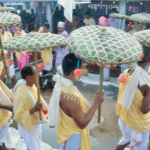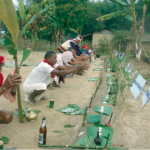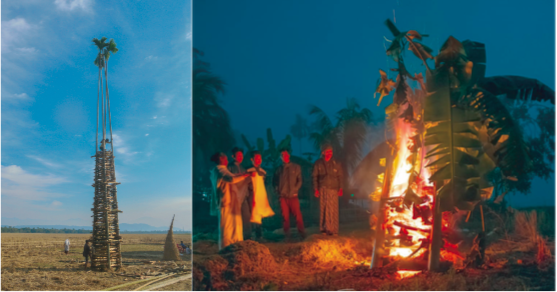When a small portion of a pudding tastes so heavenly, imagine how great it would be to taste some more or maybe the whole of it! Similar is the case when we talk about the diversity of Northeast India. Be it the picturesque beauty of each of its states or the food with its unique flavours carrying the indigenousness; be the inimitable festivals and traditions or the ethnic attires of each community weaved with tales of their originality. Northeast India is incredible in its own way! So, here’s offering some more flavours of the festivals of Northeast India.
Magh or Bhogali Bihu
The word ‘Bihu’ itself has gained such popularity across the country that when one talks about Assam, it is obvious to discuss Bihu. But many are unaware that there are three Bihu festivals celebrated with lot of fervour. All of them hold an agricultural significance and so celebrated in relevant seasons. Bhogali or Magh Bihu is celebrated in mid-January, on the first day of ‘Magh’ month of Assamese calendar. ‘Bhogali’ means handiness of rich food. So Bhogali Bihu represents a festival of food and it is related to harvesting. Bhogali Bihu is celebrated at a time when all the cultivation works get over and everyone has plenty to eat and enjoy. On this eve, people build ‘Meji’, a structure made of wood or dry leaves that is to be burnt on the actual Bihu day. This Meji is guarded day and night by all the people of the village. To stay for the night, people build temporary houses called ‘Bhela ghar’. These houses are usually made of hay. Traditionally, there used to be grand feasts for the people staying in the Bhela ghar that night. The feast is called ‘Bhoj’. On the actual day of Magh Bihu, everyone takes bath at dawn and enjoy the Meji that is lit up by one old member of the society or village. In the villages, people also witness some interesting bullfights and bird fights. Dance and music also become the order of the day as the day wears on. People also visit the homes of their friends and relatives to exchange pleasantries on the occasion of Bihu.
Moastu Mong
From the seventeen existing tribes of Nagaland, the Moatsu Mong festival is celebrated by the Ao People. The Ao Nagas observe Moatsu Mong as their designated harvest festival in the month of May. This festival brings an end to the sowing season and is a period of relaxation. People pray to the almighty to look after their lands and seek blessings for a great harvest. They also express their gratitude for the abundance of blessings received. It is also a time when the wise old men of the village predict how the upcoming year will be. People dance and sing, feast and pray. Only the best reared animals are slaughtered for their meat. The festive spirits are complete with competitions where the best made rice wine is awarded. Women and men both clad themselves in their finest traditional wears and artistic ethnic jewelry and celebrate. The festival is celebrated for three whole days. Initial festivities begin on 1st August and end on 3rd. These days, Moatsu Mong is being promoted as a national event by Nagaland Tourism, and Chuchuyimlang village is the main place of attraction for the celebrations that take place during the festival.
Kharchi Puja
Popularly known as the ‘Festival of 14 Gods’ in Tripura, Kharchi Puja is the worship of the dynasty deity of Tripuri people, the fourteen Gods. The word Kharchi is derived from two Tripuri words ‘Khar’ or Kharta meaning or Sin, ‘chi’ or ‘si’ meaning cleaning. The fourteen Gods are worshipped by the royal priest ‘Chantai’ who is not a ‘Brahmin’ but of a tribal origin. As per the 3000-year-old tradition, only the Chantai descendants can take place of the Chantai. This festival customs are completely related to the authentic Tripuri traditions, however everyone else is always welcome to enjoy and partake in this celebration. According to Tripuri legends, Ama Pechi is menstruation of mother goddess or earth mother. So the soil is not ploughed or dug anywhere during this time. Among Tripuri, the menstruation of a woman is considered as unholy, which is why during this period women are prohibited from performing any auspicious rituals. Even a priest whose wife is menstruating is prohibited from performing any auspicious or religious function. Puja is performed for seven consecutive days to wash out sins and to clean post menstrual phase of mother earth’s menstruation. On the day of puja, 14 gods are carried to Saidra River by members of Chantai where gods are bathed in holy water and are brought back to the temple. A large fair is also organised where every day lots of people throng the festivals. Both Tripuri and non-Tripuri people participate in the festival.

Solung
Celebrated by the Adi tribes of Arunachal Pradesh, Solung is a popular agricultural festival that comes after the sowing of seeds to seek prosperity and a good harvest. The ‘Solung’ of the Adis can be compared with the three Bihus of the Assamese, as they are also socio-religious in nature, which has a close connection with agriculture. To mark the celebrations, people perform various rituals and make offerings to gods and goddesses during the celebration and pray for a bumper harvest. During the seven days celebration, Mithun (Great Indian Bison) which is considered as holy animal and occupies an important religious significance among the Adis.(incomplete sentence) People present gifts of meat and Apong (rice beer) to neighbours and relatives on the occasion thus cementing family and social relationships. On the last and on the seventh day of the Solung festival, men assemble at the village dormitory generally known as ‘Mosup’ to make bows and arrows, which are fastened on the doors of every house in the village. This is done in order to resist the evil spirits from entering the houses. This day is known ‘Ekob’. The festival also reflects care and protection of animals which are vital components of their family and social life of Adi tribe.
Rongker
Rongker is a major springtime annual festival celebrated among the Karbis in the month of April to pacify local deities who are associated with the village welfare, as well as to get rid of all bad happenings. Karbis or the Karbi tribe is one of the major ethnic groups in Northeast India and especially in the hills of Assam. The key reason behind the celebration of the festival is to free people from all the diseases and natural calamities throughout the year. There are ten earthen alters installed in the eastern side of the site where the festival is supposed to be held. They are kept in a row that faces the south-north direction. This festival lasts for three days and one of the rituals is where all the deities are invoked. The main rituals are performed by the head priest who is assisted by other religious specialists and the village headman. In one of the unique rituals performed at night on the second day of the festival, the evil spirits are driven out from the lower to the upper part of the village by dancing. At the end of the village road an altar is made where a chicken is sacrificed in the name of a deity. A feast is organised when the rituals are over. This festival has some special features where some specific activities are not to be performed during this period. Fore.g., husking, where women are not supposed to participate, no agricultural activities are to be performed and no villager is allowed to leave the village. During this festival twelve deities are worshipped.

Festivals form an essential aspect of the socio-cultural life of the people of a state and as a matter of fact, festivals are the mirror of the people’s culture. However, it would be worth mentioning that Northeast India is such a region where one state is not limited to just one or two tribal communities. A state like Arunachal Pradesh has 26 major tribes and more than 100 sub tribes, similarly Nagaland has 17 tribes and the count in other states are no different. And each of these tribes has their own unique culture and customs. Additionally, this region is probably one of the last remaining outposts in the country where tribes still live a primitive existence, seeking out a living from the land and maintaining a harmonious relation with nature. Reading on them would leave one with knowledge and imagination, but visiting and witnessing the cultural bonanza would for sure leave one with a lifetime experience!


 [/column]
[/column]